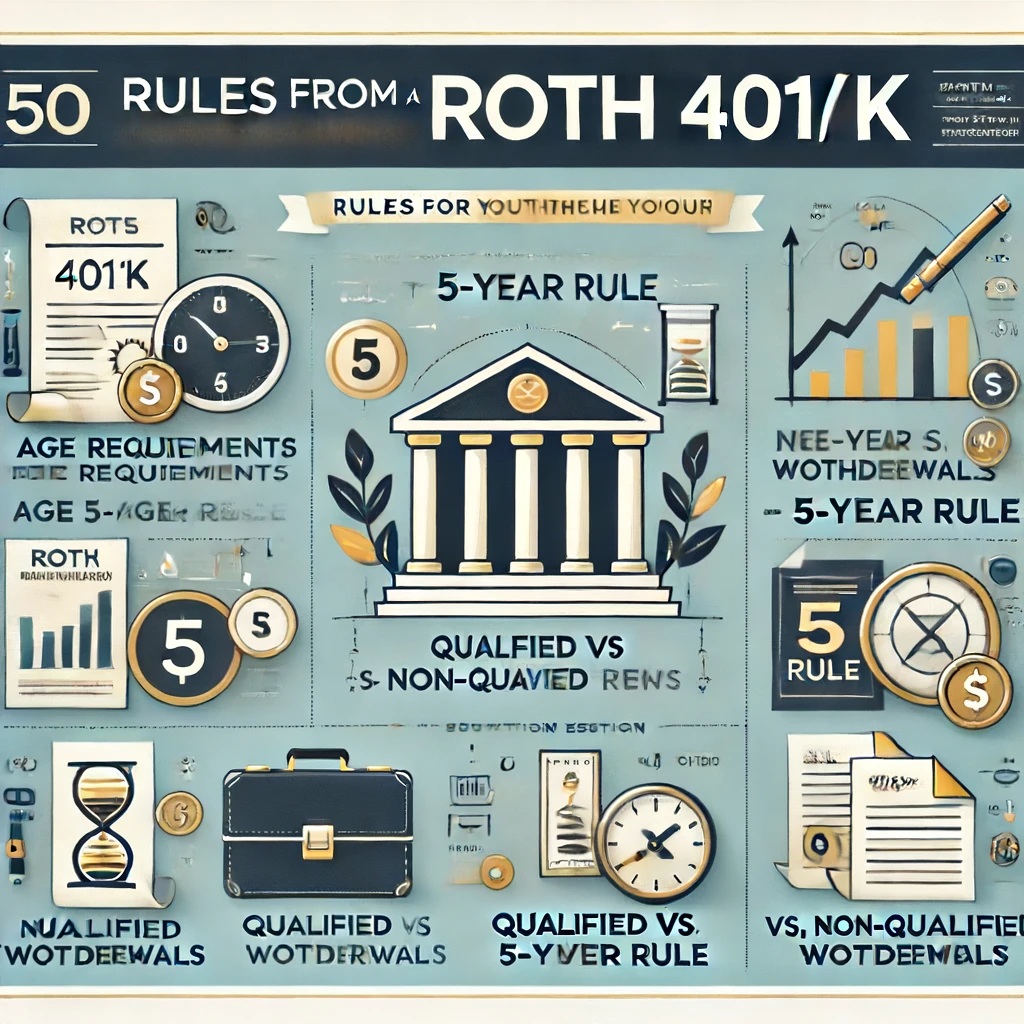When Can I Withdraw from My Roth 401(k)?
Navigating the world of retirement accounts can be tricky, and the Roth 401(k) is no exception. Whether you’re nearing retirement or just curious about your options, understanding how and when you can withdraw from your Roth 401(k) is crucial. In this article, we’ll dive deep into the ins and outs of Roth 401(k) withdrawals. By the end, you’ll have a comprehensive understanding of the rules and best practices for accessing your hard-earned savings.
Contents
What Is a Roth 401(k)?
Before we get into the specifics of withdrawals, let’s take a quick refresher on what a Roth 401(k) is. A Roth 401(k) is a retirement savings account that combines the features of a traditional 401(k) and a Roth IRA. Contributions are made with after-tax dollars, meaning you don’t get a tax break upfront. However, the real benefit comes later – your withdrawals in retirement are tax-free.
When Can I Withdraw from My Roth 401(k)?
So, when can I withdraw from my Roth 401(k)? The answer depends on a few factors, including your age, the length of time your account has been open, and whether you meet certain criteria.
Age Matters: The 59½ Rule
One of the primary rules governing Roth 401(k) withdrawals is the age requirement. To make penalty-free withdrawals from your Roth 401(k), you generally need to be at least 59½ years old. This age threshold aligns with the retirement rules for many other tax-advantaged accounts.
The 5-Year Rule
Besides the age requirement, there’s also the 5-year rule. This rule requires that your Roth 401(k) be open for at least five years before you can take out any earnings without facing penalties. Here’s how it works:
- If you opened your Roth 401(k) in 2020, you would need to wait until at least 2025 to make tax-free withdrawals of the account’s earnings.
- The five-year period starts on the first day of the tax year in which you made your first contribution to the Roth 401(k).
It’s essential to understand this rule to avoid unexpected taxes and penalties.

Types of Withdrawals: Qualified vs. Non-Qualified
When discussing when I can withdraw from my Roth 401(k), it’s crucial to distinguish between qualified and non-qualified withdrawals.
Qualified Withdrawals
Qualified withdrawals are those that meet both the age (59½) and the 5-year rule requirements. These withdrawals allow you to take out both your contributions and earnings tax-free and penalty-free.
Non-Qualified Withdrawals
Non-qualified withdrawals occur when you take out money from your Roth 401(k) before meeting the age and/or the 5-year rule requirements. While you can always withdraw your contributions (the money you put in) tax-free and penalty-free, withdrawing the earnings can result in taxes and penalties. The earnings portion of your withdrawal may be subject to income tax and a 10% early withdrawal penalty.
Exceptions to the Rules
While the guidelines above cover the basics, some exceptions allow for penalty-free withdrawals under specific circumstances. Understanding these exceptions can help you access your funds without incurring unnecessary penalties.
Disability
If you become disabled, you can withdraw funds from your Roth 401(k) without facing the 10% early withdrawal penalty. It’s essential to meet the IRS’s definition of disability to qualify for this exception.
Medical Expenses
Withdrawals made to cover unreimbursed medical expenses that exceed 7.5% of your adjusted gross income can be exempt from the early withdrawal penalty.
First-Time Home Purchase
Although primarily associated with Roth IRAs, there are limited provisions for using Roth 401(k) funds for a first-time home purchase. However, this is less common and should be considered carefully.
Qualified Domestic Relations Order (QDRO)
If you are required to split your Roth 401(k) as part of a divorce settlement, the recipient can withdraw the funds without incurring the early withdrawal penalty.
Strategies for Managing Roth 401(k) Withdrawals
Knowing when can I withdraw from my Roth 401(k) is just one part of the equation. Planning your withdrawals strategically can make a significant difference in your retirement.
Prioritize Contributions and Withdrawals
It’s beneficial to prioritize contributions and withdrawals strategically. Since contributions to a Roth 401(k) are made with after-tax dollars, it’s wise to withdraw from accounts where you’ll pay the least amount of tax first. In retirement, this often means tapping into traditional accounts before Roth accounts, allowing your Roth 401(k) to continue growing tax-free.
Consider Your Tax Bracket
Withdrawals from a Roth 401(k) are tax-free, which can be a significant advantage if you expect to be in a higher tax bracket in the future. By delaying withdrawals from your Roth 401(k), you can potentially minimize your overall tax burden in retirement.
Plan for Required Minimum Distributions (RMDs)
Unlike Roth IRAs, Roth 401(k)s are subject to required minimum distributions (RMDs) starting at age 73. However, you can avoid RMDs by rolling your Roth 401(k) into a Roth IRA before you reach this age. This strategy allows you to keep your funds growing tax-free for as long as you wish.
Frequently Asked Questions
Can I Withdraw Contributions Without Penalty?
Yes, you can always withdraw the contributions (the money you put in) from your Roth 401(k) without paying taxes or penalties. This flexibility is one of the significant advantages of a Roth account.
What Happens if I Withdraw Before 59½?
If you withdraw earnings from your Roth 401(k) before reaching 59½, you may face both income taxes and a 10% early withdrawal penalty on the earnings portion. There are exceptions, as mentioned earlier, but these should be navigated carefully.
Can I Roll Over My Roth 401(k) to a Roth IRA?
Yes, rolling over your Roth 401(k) to a Roth IRA is a common strategy, especially to avoid RMDs and gain more control over your investments. Ensure you follow the proper steps to avoid any tax complications.
Conclusion
Understanding when I can withdraw from my Roth 401(k) is essential for anyone planning their retirement. By knowing the rules and exceptions, you can make informed decisions that maximize your retirement savings and minimize tax liabilities. Whether you’re planning for the near future or several years down the road, having a solid withdrawal strategy in place can help ensure a comfortable and financially secure retirement.
If you have any questions or need personalized advice, don’t hesitate to reach out to a financial advisor who can help you navigate your specific situation. At Carmichael Hill, we’re here to help you make the most of your retirement planning.


Comments are closed.